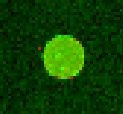Human/Mouse Pin1 Antibody Summary
Ala2-Glu163
Accession # Q13526
Applications
Please Note: Optimal dilutions should be determined by each laboratory for each application. General Protocols are available in the Technical Information section on our website.
Scientific Data
 View Larger
View Larger
Detection of Human/Mouse Pin1 by Western Blot. Western blot shows lysates of Balb/3T3 mouse embryonic fibroblast cell line, U2OS human osteosarcoma cell line, HeLa human cervical epithelial carcinoma cell line, MCF-7 human breast cancer cell line, and MDA-MB-453 human breast cancer cell line. PVDF membrane was probed with 0.5 µg/mL of Mouse Anti-Human/Mouse Pin1 Monoclonal Antibody (Catalog # MAB2294) followed by HRP-conjugated Anti-Mouse IgG Secondary Antibody (Catalog # HAF007). A specific band was detected for Pin1 at approximately 20 kDa (as indicated). This experiment was conducted under reducing conditions and using Immunoblot Buffer Group 1.
 View Larger
View Larger
Pin1 in MCF-7 Human Cell Line. Pin1 was detected in immersion fixed MCF-7 human breast cancer cell line using Mouse Anti-Human/Mouse Pin1 Monoclonal Antibody (Catalog # MAB2294) at 8 µg/mL for 3 hours at room temperature. Cells were stained using the NorthernLights™ 557-conjugated Anti-Mouse IgG Secondary Antibody (red; Catalog # NL007) and counterstained with DAPI (blue). Specific staining was localized to nuclei and cytoplasm. View our protocol for Fluorescent ICC Staining of Cells on Coverslips.
 View Larger
View Larger
Pin1 in Human Breast Cancer Tissue. Pin1 was detected in immersion fixed paraffin-embedded sections of human breast cancer tissue using Mouse Anti-Human/Mouse Pin1 Monoclonal Antibody (Catalog # MAB2294) at 25 µg/mL overnight at 4 °C. Tissue was stained using the Anti-Mouse HRP-DAB Cell & Tissue Staining Kit (brown; Catalog # CTS002) and counterstained with hematoxylin (blue). Specific labeling was localized to the cytoplasm of epithelial cells. View our protocol for Chromogenic IHC Staining of Paraffin-embedded Tissue Sections.
Reconstitution Calculator
Preparation and Storage
- 12 months from date of receipt, -20 to -70 °C as supplied.
- 1 month, 2 to 8 °C under sterile conditions after reconstitution.
- 6 months, -20 to -70 °C under sterile conditions after reconstitution.
Background: Pin1
Pin1 is a peptidyl-prolyl isomerase (PPI) that targets phosphorylated Ser or Thr residues followed by a Pro (S/T-P). Isomerization of phosphorylated Ser or Thr residues may alter protein confirmation and, subsequently, modify activity. Pin1 is overexpressed in many human breast cancers, and has been shown to modify numerous proteins including p53,NF-kappa B, c-Jun, cyclin D1, and beta -catenin.
Product Datasheets
Citations for Human/Mouse Pin1 Antibody
R&D Systems personnel manually curate a database that contains references using R&D Systems products. The data collected includes not only links to publications in PubMed, but also provides information about sample types, species, and experimental conditions.
7
Citations: Showing 1 - 7
Filter your results:
Filter by:
-
The fission yeast Pin1 peptidyl-prolyl isomerase promotes dissociation of Sty1 MAPK from RNA polymerase II and recruits Ssu72 phosphatase to facilitate oxidative stress induced transcription
Authors: YT Wang, WY Hsiao, SW Wang
Nucleic Acids Research, 2021-01-25;49(2):805-817.
Species: Human
Sample Types: Cell Lysates
Applications: Western Blot -
TLR-7 Stress Signaling in Differentiating and Mature Eosinophils Is Mediated by the Prolyl Isomerase Pin1
Authors: ZJ Shen, J Hu, V Kashi, YA Bochkov, JE Gern, JS Malter
J. Immunol., 2018-11-05;0(0):.
Species: Mouse
Sample Types: Cell Lysates
Applications: Immunoprecipitation -
The peptidyl-prolyl isomerase Pin1 up-regulation and proapoptotic function in dopaminergic neurons: relevance to the pathogenesis of Parkinson disease.
Authors: Ghosh A, Saminathan H, Kanthasamy A, Anantharam V, Jin H, Sondarva G, Harischandra D, Qian Z, Rana A, Kanthasamy A
J Biol Chem, 2013-06-10;288(30):21955-71.
Species: Human
Sample Types: Tissue Homogenates
Applications: Western Blot -
A distinct role for Pin1 in the induction and maintenance of pluripotency.
Authors: Nishi M, Akutsu H, Masui S
J. Biol. Chem., 2011-02-04;286(13):11593-603.
Species: Human
Sample Types: Cell Lysates
Applications: Immunoprecipitation -
The peptidyl-isomerase Pin1 regulates p27kip1 expression through inhibition of Forkhead box O tumor suppressors.
Authors: Brenkman AB, de Keizer PL, van den Broek NJ, van der Groep P, van Diest PJ, van der Horst A, Smits AM, Burgering BM
Cancer Res., 2008-09-15;68(18):7597-605.
Species: Human
Sample Types: Whole Cells, Whole Tissue
Applications: ICC, IHC-P -
Protein Never in Mitosis Gene A Interacting-1 (PIN1) regulates degradation of inducible nitric oxide synthase in endothelial cells.
Authors: Liu T, Huang Y, Likhotvorik RI, Keshvara L, Hoyt DG
Am. J. Physiol., Cell Physiol., 2008-07-23;295(3):C819-27.
Species: Mouse
Sample Types: Cell Lysates
Applications: Immunoprecipitation, Western Blot -
Pin1 regulates TGF-beta1 production by activated human and murine eosinophils and contributes to allergic lung fibrosis.
Authors: Shen ZJ, Esnault S, Rosenthal LA, Szakaly RJ, Sorkness RL, Westmark PR, Sandor M, Malter JS
J. Clin. Invest., 2008-02-01;118(2):479-90.
Species: Mouse
Sample Types: Cell Lysates
Applications: Western Blot
FAQs
No product specific FAQs exist for this product, however you may
View all Antibody FAQsReviews for Human/Mouse Pin1 Antibody
Average Rating: 5 (Based on 1 Review)
Have you used Human/Mouse Pin1 Antibody?
Submit a review and receive an Amazon gift card.
$25/€18/£15/$25CAN/¥75 Yuan/¥2500 Yen for a review with an image
$10/€7/£6/$10 CAD/¥70 Yuan/¥1110 Yen for a review without an image
Filter by:


